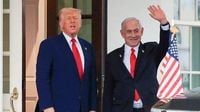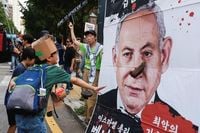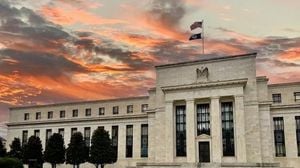On September 29, 2025, the diplomatic spotlight turned to Washington as Israeli Prime Minister Benjamin Netanyahu and U.S. President Donald Trump emerged from the White House with the announcement of a long-anticipated peace plan for Gaza. The proposal, which has yet to receive final approval from all parties, marks a pivotal moment in the ongoing conflict that has left the region battered and the international community deeply divided.
The plan itself is bold and, in many ways, unprecedented. According to ARA, it proposes a kind of U.S. protectorate over the Gaza Strip, with the United States at the helm of a transitional administration. Former British Prime Minister Tony Blair is slated to participate, but Trump himself would lead the effort, stating, “the leaders of the Arab world and Israel, and everyone involved have asked me to do so.” This arrangement would see Washington collaborating with Arab and international partners to set up temporary security forces, dubbed the International Stabilization Force (ISF), tasked with ensuring safety and overseeing the demilitarization of Gaza.
Netanyahu, whose fourth visit to Washington during the current conflict comes as the death toll in Gaza has reached a staggering 66,000, made his position clear: if Hamas does not accept the terms of the agreement, Israel will “finish the job” in Gaza. Trump, echoing this sentiment, promised that Israel would have the “full support” of the United States to achieve this goal. The threat underscores the high stakes and intense pressure now bearing down on the Palestinian group, which has been given the proposal by Qatari and Egyptian intermediaries and is currently reviewing it “with goodwill.”
What exactly does the plan entail? For one, it guarantees that “no one will be forced to leave Gaza, and those who wish to leave are free to do so as well as to return.” The future of the Palestinian state remains ambiguous, recognized only as an “aspiration” and made conditional on a series of reforms, particularly to the Palestinian Authority. If these reforms are completed and the process runs its course, “the conditions could finally lead to a credible path toward self-determination and a state of their own for the Palestinians,” the plan states.
Should Hamas accept the deal, all hostages would be released “immediately, and no later than 72 hours,” according to the White House document. In exchange, Israeli forces would withdraw to the Rafah line, suspending all military operations and freezing battle lines until milestones for a phased withdrawal are met. The ISF would be deployed immediately, with its withdrawal tied to the demilitarization of Gaza, a process to be monitored by the IDF, ISF, and international guarantors, including the United States.
Yet, the plan’s details on the day-to-day life for Gazans after the war remain vague, and many in the international community are wary. According to Atalayar, Israel now faces growing international isolation. A host of United Nations member states—including the United Kingdom, France, Australia, Canada, and Spain—have recognized a Palestinian state. The UN has also formally accused Israel of genocide in Gaza, and the International Criminal Court has issued an arrest warrant for Israeli leaders on charges of war crimes. These developments have put Israel under immense diplomatic and legal pressure, casting a long shadow over the White House announcement.
Inside Israel, the situation is no less fraught. Protests have surged, led by families of hostages held in Gaza, who demand more decisive government action. These demonstrations reflect broader discontent with the government’s handling of the crisis and raise questions about its overall strategy. The internal unrest adds another layer of complexity to Netanyahu’s negotiations, as he must balance domestic expectations with international realities.
Netanyahu’s recent speech at the UN General Assembly only deepened the divides. Standing before a largely empty chamber—many delegates had left in protest—the Israeli prime minister rejected the recognition of a Palestinian state, calling it a “shameful” act and likening it to “promoting a terrorist state a short distance from New York,” a pointed reference to the September 11 attacks. The strong words underscored his government’s hardline stance, which is increasingly at odds with the prevailing mood among Western allies and much of the global community.
Trump, for his part, has sought to position himself as a peacemaker, touting his efforts to bring stability to the Middle East and even eyeing the Nobel Peace Prize. He has also set boundaries for Israel, opposing any annexation of the West Bank and insisting on an immediate ceasefire. These positions have caused friction with Netanyahu, exposing a rare rift in the U.S.-Israel alliance. According to Atalayar, the delicate balance between supporting Israeli security and striving for sustainable peace with the Palestinians has never been more precarious.
The peace plan’s fate is also tied to broader regional dynamics. The Abraham Accords, which normalized relations between Israel and several Arab states, are now at risk if the current negotiations falter. The success or failure of the plan could reshape not just Gaza, but Israel’s alliances across the Middle East. Arab and Muslim countries have made it clear that peaceful coexistence between Israel and a future Palestinian state is a non-negotiable requirement for progress, a point echoed by U.S. diplomats.
Notably absent from the talks is Iran, whose influence in the region—particularly through support for armed groups opposed to Israel—remains a complicating factor. The lack of Iranian involvement leaves a significant gap in the negotiations and raises questions about the long-term viability of any agreement that does not address Tehran’s role in the conflict.
Behind the scenes, U.S. special envoy Steve Witkoff and Jared Kushner, Trump’s son-in-law, met with Netanyahu the day before the White House announcement to urge him to support the plan. Kushner, who has previously spoken about the economic potential of Gaza’s waterfront, represents the intersection of diplomacy and business that has characterized much of the Trump administration’s approach to the region.
As the world waits for Hamas’s response, the future of Gaza—and the broader Middle East—hangs in the balance. The plan’s emphasis on demilitarization, international oversight, and a gradual transition to civilian administration represents a significant shift from previous proposals. But with deep mistrust on all sides, ongoing violence, and the specter of international legal action, the road to peace remains uncertain.
For now, the eyes of the world remain fixed on Washington, Tel Aviv, and Gaza, as leaders grapple with a plan that could either end one of the 21st century’s most intractable conflicts or usher in a new chapter of uncertainty and unrest.






